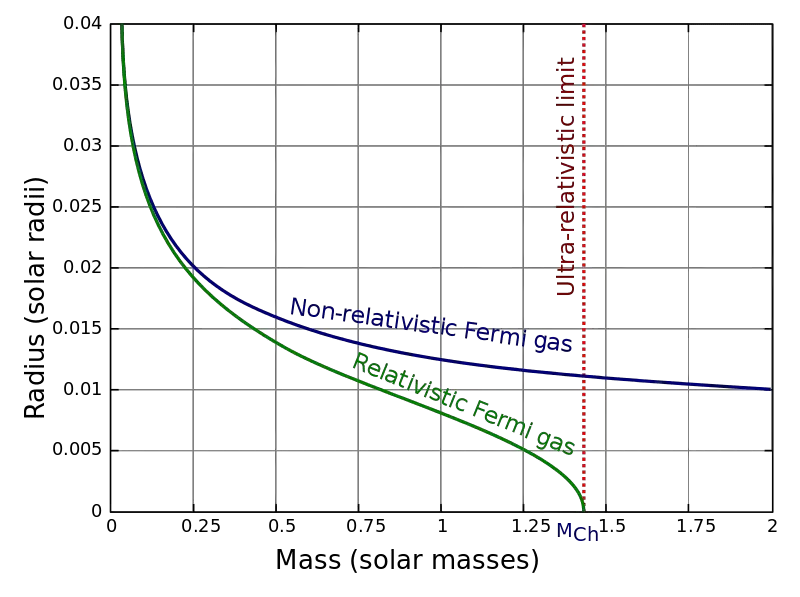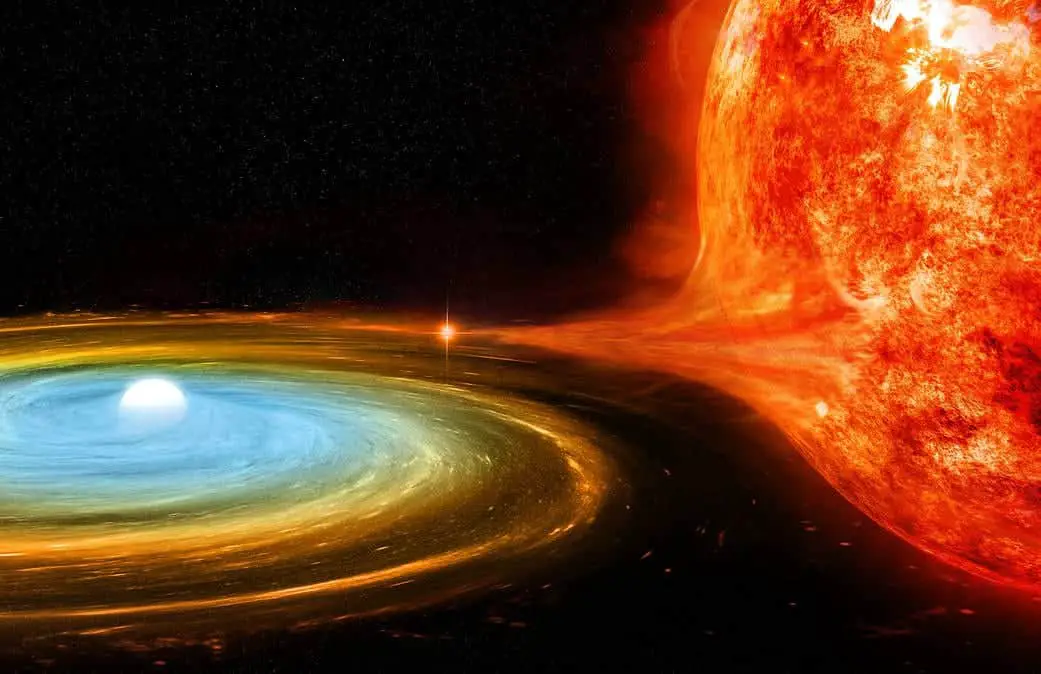Whatever is born must die at some time. It is inevitable. So is the fate of a white dwarf. But, for that to happen, the stellar mass of a white dwarf should exceed the Chandrasekhar limit. It is the maximum mass a stable white dwarf can have. Above that, a white dwarf will collapse into either a neutron star or a black hole.
In this article, I will be discussing every aspect of the Chandrashekar limit. So just buckle up. And, get ready for the nasty ride. Here are some questions you should be asking about Chandrasekhar Limit – Death Warrant Of White Dwarf….!!!!
- Death of a star
- What is the Chandrasekhar limit?
- Historical view of Chandrasekhar Limit
- Historical view of White Dwarf
- formation of a white dwarf
Death Of A Star
Well, for a white dwarf to come into existence, a star has to die first. As I said in the introductory paragraph that whatever is born must die at some time. So, when the stellar core of a star runs out of its fuel, it gravitationally collapses under its own gravity. In simple terms, when there is no fuel left, a star dies. Here comes the catch. When a star dies, it can either become a neutron star or a black hole. Or simply, the death of a star can cause the birth of a white dwarf too.
Obviously, you would be thinking that how to define the ultimate fate of a dying star..!! I mean, a dying star could become so many different stellar objects. How to make sure that it will eventually become a white dwarf. Well, here comes the role of the Chandrashekar limit.
Editor’s Choice: Astronomers Detect Black Hole and Neutron Star merger: First of its Kind
What Is The Chandrasekhar Limit?
Chandrasekhar’s limit is nothing but an upper mass limit for white dwarf stars. In more simple terms, if the stellar core remnant of a dead star is below or up to this limit, it won’t further collapse. Hence, its final fate will be a white dwarf. The scientifically accepted value of the Chandrasekhar limit is approximately 1.4 solar masses.

In 1931, this mass limiting formula was derived by an Indian American physicist named Subrahmanyan Chandrashekhar. That’s why it bears his name. In a similar fashion, there is an upper mass limit for neutron stars too. Above the Tolman–Oppenheimer–Volkoff limit, the neutron star will gravitationally collapse and eventually form a black hole.
Unlike, the Chandrasekhar limit, the TOM limit does not have an exact value. Therefore, it is still debatable within the scientific community. Well, I can’t discuss in detail neutron star and its uncertain mass limiting formula. I strongly recommend you to see this article for a further detailed explanation. I am sure you will like it.
Historical View Of Chandrasekhar Limit
Well, before the emergence of modern physics, the whole scientific community believed in the classical picture of the observable universe. According to classical laws, physicists believed that no force is capable enough to support the stars from gravitationally collapsing under its own weight. But, according to quantum mechanical laws, there could be a force that could withstand the collapsing of a stellar object under its own gravity.
must read, What If Planet Nine Is A Primordial Black Hole?
In 1926, this observation was done by a British astronomer and physicist Ralph H. Fowler. He explained the relationship between the white dwarf’s temperature, density, and energy by using the non-relativistic effects of electrons and nuclei that directly obeyed the fermi-Dirac statistics. But, sadly, his observations were not quite good enough to explain the complete picture of the observed high density of the white dwarf stars. Perhaps, his theoretical work laid the groundwork for further study about the high density of the white dwarfs.

Five years later, in 1931, Subrahmanyan Chandrasekhar, his graduate student; took the relativistic effects into account and fused it with the quantum mechanical work of Ralph H. Fowler. Hence, by utilizing the complete modern physics i.e Quantum physics and theory of relativity, he developed the mathematically correct upper mass limit of the white dwarfs. As of now, this upper mass limit formula for the white dwarfs is famously known as the Chandrasekhar limit.
Controversy Around Chandrasekhar Limit
Well, Chandra’s Chandrasekhar limit was one of the most controversial findings of that era. Simply because, if his theory of white dwarf is correct (as it is), then black holes could exist in reality. I mean, even Einstein did not believe that black holes could exist in reality. So, how others can?
At that time, most of physicists believed that the white dwarf is the final and eventual fate of every star. One of the most noted opposing figures was the famous British astrophysicist Arthur Eddington. He openly criticized S. Chandrashekhar’s idea. In fact, in 1935, after a talk delivered by Chandra on his findings; Eddington replied
The star has to go on radiating and radiating and contracting and contracting until, I suppose, it gets down to a few km radius, when gravity becomes strong enough to hold in the radiation, and the star can at last find peace. … I think there should be a law of Nature to prevent a star from behaving in this absurd way.
He simply discarded the idea that black holes could exist in reality. Though, he believed in the mathematical theory of black holes. Finally, with the discovery of neutron stars in 1967, scientists accepted that black holes do exist. And with that, almost a half-century later of his theoretical finding, in 1983, Chandra finally got his Nobel prize sharing with his mentor Ralph H. Fowler.
Historical View Of White Dwarf
Before going ahead, let me tell you one thing. Just because the death warrant of white dwarfs was signed by S. Chandrasekhar; doesn’t mean that he was the first one to discover the white dwarf in the night sky. In fact, almost 2 centuries before the Chandrasekhar limit, the first white dwarf was discovered. Well, at that time, it was not known as a White dwarf. The name white dwarf was coined by dutch American astronomer William Luyten in 1922.
must read, Top 6 Obsolete cosmological Theories Of The Universe
The first-ever white dwarf i.e 40 Eridani B was discovered by german-British astronomer William Herschel in 1783. The 40 Eridani is a triple star system located in the constellation of Eridanus. The main-sequence star of 40 Eridani is known as 40 Eridani A. The red dwarf is known as 40 Eridani C. Similarly, the white dwarf in the 40 Eridani system is known as 40 Eridani B.
Till today, over 9000 white dwarfs have been discovered in the night sky. The closest white dwarf to our solar system is Sirius B. It is located in the Sirius star system. Sirius is a binary star system that contains a main-sequence star i.e Sirius A and a white dwarf i.e Sirus B.
Formation Of A White Dwarf
Ok. As of now, you know that what is Chandrasekhar’s limit and all the history behind its discovery and white dwarfs. Therefore, you are in a perfect position to know what role does Chandrasekhar limit plays in the formation of a white dwarf.
Well, according to the classical view, when a star collapses, it will eventually become a white dwarf as its final fate. But, if we talk in terms of Chandrasekhar limit (modern view), a white dwarf is not the final fate of all the stars. Meaning, it could become a neutron star or simply a black hole. Ahh, don’t be baffled. I will tell you how.
See, for a star to become a black hole, its mass should be above 29.0 solar masses. Similarly, for a star to become a neutron star, its mass should be in the range of 10.0 to 29.0 solar masses. Finally, for a star to become a white dwarf, its mass should be in the range of 0.07 to 10.0 solar masses.
Chandrasekhar Limit and White Dwarf
When a star runs out of its nuclear fuel, it will continue to collapse until some kind of internal force comes into action and prevents itself from further collapsing. In the case of white dwarfs, this equilibrium position is achieved by the pressure of the electrons. Here, the electron degeneracy pressure will prevent the further collapsing of a star under its own gravity. Just because of this reason, white dwarfs are also known as the degenerate dwarfs.
must read, Will The Sun Become A White Dwarf – WHY?
Well, if you don’t know, white dwarfs can further be classified into three different categories. I have explained everything about the journey of a star to a white dwarf in this article. Check it out. I am sure you will love it. But, I will also give a quick review here too.
The first classification of a white dwarf is known as small-sized stars i.e its mass is between 0.07 to 0.5 solar masses. The next in the line is medium-sized stars i.e its mass is between 0.5 to 8.0 solar masses. The next and last in the line is a large-sized star i.e its mass is between 8.0 to 10.0 solar masses.
You know, astronomers and scientists believe that when a white dwarf will radiate all its thermal energy, it will eventually become a black dwarf. But we haven’t found any of a hypothetical black dwarf. Do you know why? well if you do, enlighten me with your thoughtfulness in the comment section. I am waiting.
That’s it for this post. If you like this article, share it if you like it, like it if you share it. You can also find us on Mix, Twitter, Pinterest, and Facebook. Hey man, If you have come this far, do give us feedback in the comment section. It would make my day. Cheers!!!

It’s because they’re black I guess! You can only see light things in telescopes. But, there may be very few black dwarfs in the milky way because it isn’t old enough. There is a steep drop in the luminosity function between M and L type stars where white dwarfs end and brown dwarfs begin. From this you can measure a maximum in age for white dwarfs in the milky way from how luminous the dimmest (and oldest) ones are and it gives you a number of less than 11 billion years. Maybe that’s not enough time?
Hey George, you definitely have enlightened me with your well-articulated thought. Thanx for stopping by. Keep visiting us!!!
hey and thanks for this interesting article.